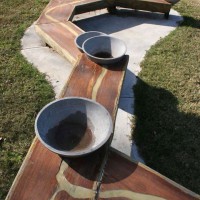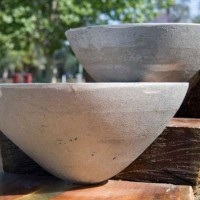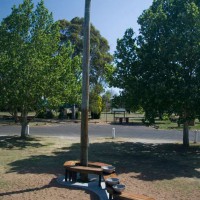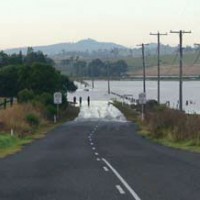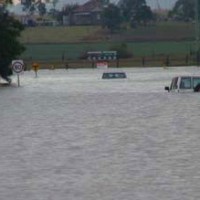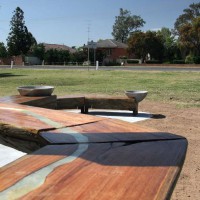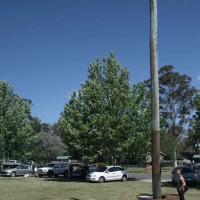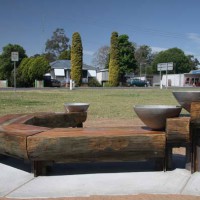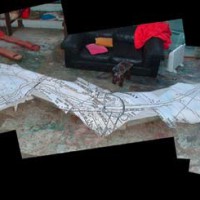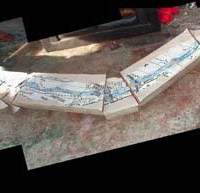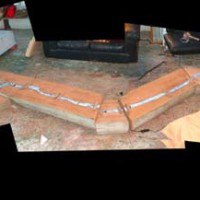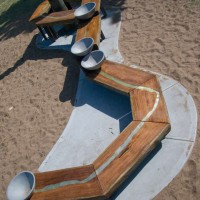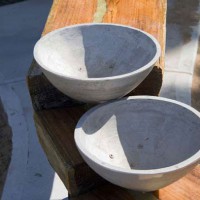Hunter River Sculpture
Materials:
Hardwood, recycled aluminium, steel and resin.
Concept:
Artist Tricia Flanagan worked with the Singleton Public Art Committee for two months in 2007 to create the ‘Hunter River Sculpture’. The Hunter River is the theme of the sculpture. The river has a history that connected Singleton to the rest of the world and has been the life force for the region. The importance of the river to the traditional indigenous owners of the area is a significant and spiritual one. Since Benjamin Singleton first drove stock from Sydney to graze the fertile pastures of the region, the river has provided early settlers with a means of transport, water for agriculture and a source for growth.
The river is written into Singleton’s history books and resonates in personal histories and the collective memory of the community as the water level has risen and fallen over time.
The bridges that cross the river are a secondary element in the sculpture. The four bridges represent different periods of history – access to land and engineering expertise. In recent times the Hunter River is again the focus of attention, as an awareness grows that water is a precious natural resource that needs to be cared for by every Australian.
The sculpture is an organic form, constructed from timber, which follows the shape of the river. Four levels, from high to low flow in the direction that the river flows – down toward the sea. A map of the Hunter river is carved into the timber surface of each level, inlaid with silver aluminium plate. At one end of each level is an aluminium bowl. The bowls are sand cast from hand carved patterns, from reclaimed aluminium (collected by the community). The bowls are placed on the river map to represent the four bridges. On the highest level of the sculpture the river splits into two arms and rejoins again further south. In the loop created, a vertical element shoots skyward. This pole is tapered at the top; the point is coated with aluminium plate, a landmark and beacon, glinting in the sun. Bands of aluminium decorate the pole reminiscent of the rise and fall of the river in flood over time.
‘The Hunter River Sculpture’ involved thirty-two Singleton residents in the process of design and construction of a public artwork for Singleton. The core group, Singleton Public Art Committee consisted of fifteen people. Eight local public housing tenants also participated at various stages, particularly during an onsite workshop. The project has attracted ongoing media attention.
Singleton community has created an iconic artwork at the gateway to Singleton; on the Highway leading into town. The participants in the Singleton public art project have, under the guidance of artist Tricia Flanagan, conceived of and built a large public artwork and through this process developed skills in organising a community project. They have developed new links between members and a wide variety of professionals in Singleton in the private sector and within council. The committee has established itself as an effective network for future projects and brought individual artists together to share skills and provide a supportive network for each other in their individual arts practices.
The project has helped the community gain a renewed sense of identity, ownership and pride of place. The success of the project has built realistic, workable relationships between the council authorities and the community and increased social capital in Singleton generally.
In February 2007, Arts Upper Hunter RADO, Jenny Hicks advertised for and consequently held a public meeting in Singleton announcing the Teatro Exo Singleton Public Art Project. She also gave a presentation to Singleton TAFE’s Art teacher and their adult student class and personally invited the involvement of Singleton Council’s, Community Services Officer and Youth programs Officer. The meeting gave an overview of Regional Arts NSW, Arts Upper Hunter and the upcoming project and resulted in a committee of interested people to help formulate ideas and drive the project.
Between February and early April additional meetings were held with the Singleton Public Art Committee – predominantly local practising artists and Tricia Flanagan, (artist in residence), Jenny Hicks (Regional Arts Development Officer) and Mark Reedman (Singleton Youth Services Officer). Attendance increased at each meeting and discussions were wide and varied about the nature of the project, it’s significance to the community, the history of Singleton, it’s future, what the community of artists felt it should represent, where it should be and what it should be. Based on these discussions, at the fourth meeting Flanagan presented three concepts to the committee and they decided upon a place and a sculpture. That proposal was submitted to council and a Development Application approval granted.
The aim of the project was to design and manufacture a public art work that involves the communities artists in skills development, creates a sculpture that becomes a landmark in Singleton, and responds to the environmental issue of water and Singleton’s connection to the Hunter river.
Flanagan spent a weekend with two Singleton sculptors (committee members) sourcing materials for the sculpture from other committee member’s properties. The bulk of materials were found around Singleton, and donated from the community. Telegraph poles, donated by Singleton Council and Power Serve, became a major source of work material. The committee collected aluminium bits and pieces to be melted down for bowls. There was a small budget of AU $1000 for materials.
The sculpture was built by Tricia Flanagan and the Singleton Public Art Committee and given to the community of Singleton. The centre pole was sculpted on site at Town Head Park and erected by Energy Australia. The lower section of the sculpture was constructed in a studio at Redbarn Gallery on Sheri McEvoy’s (a committee member) property at Elderslie. The work was moved by truck to Town Head Park and installed with a crane and cemented into concrete footings in July 2007. A concrete footprint under the sculpture completed the installation.
Project partners:
- Singleton Public Art Committee, Singleton Council, Arts Upper Hunter, The University of Newcastle.
Exhibitions:
- ‘Public Art and Alternative Tactics in Post-Acquisitive Society, Part One: Rural’, Hellen Rose Schaumberger Labratorium, Surry Hills Australia. Dec 2008.
- Hunter River Sculpture – Public Artwork, Town Head Park, New England Highway, Singleton, Permanent public display launched October 6th 2007.
Publications:
- NICHOLSON, B. (2007) Launch of Singleton Public Art Project ‘River Sculpture’. Artsbark. Oct., No. 30. ed., Arts Upper Hunter. P. 1.
- SNEDDON, D. (2007) Creative Seating. The Singleton Argus. 5th Jun, ed. Singleton. P. 6.
- OLDKNOW, R. (2007) Art Project Kicks Off. The Singleton Argus. 11th May, ed. Singleton. P. 15.
- HICKS, J. (2006) Artist in Residence Public Art Projects. Artsbark. No. 25, ed., Arts Upper Hunter, Front Cover.
- THOMPSON, F. (2006) Artist Warms to Subjects as River Path Brings Town to Life. The Newcastle Herald. Newcastle, p. 13.
- FERGUSON, A. (2006) Singleton Art Projects. Hunter Valley News. 15th Nov. ed. Muswellbrook. P. 15.
Thanks:
Funded by the Commonwealth Regional Arts Fund, The Department of Housing, Australian Postgraduate Research Scholarship With generous support from Power Serve, Energy Australia, Boral Concrete, Singleton Council, Arts Upper Hunter Inc. The University of Newcastle, Craig and Brad Singleton and James Thomas.
